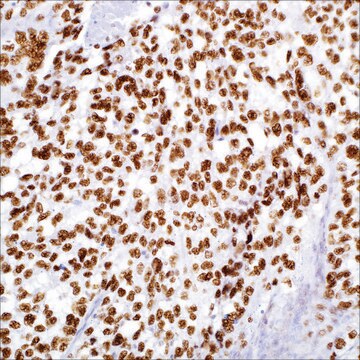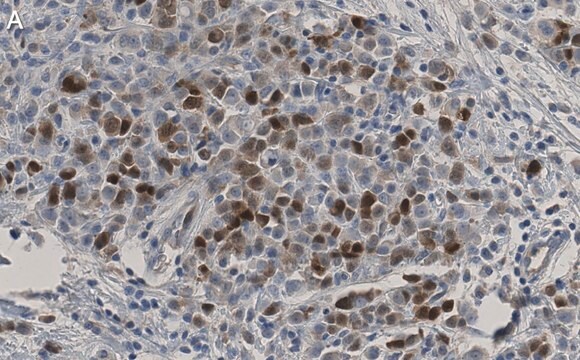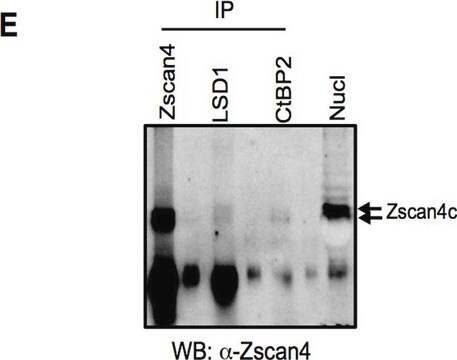推薦產品
生物源
rabbit
抗體表格
affinity isolated antibody
抗體產品種類
primary antibodies
無性繁殖
polyclonal
形狀
buffered aqueous solution
分子量
~60 kDa
物種活性
mouse, human
包裝
antibody small pack of 25 μL
濃度
~1.0 mg/mL
技術
immunoblotting: 4-8 μg/mL using human HeLa cells extract
immunofluorescence: 2.5-5 μg/mL using mouse embryo fibroblast NIH-3T3 cells
UniProt登錄號
運輸包裝
dry ice
儲存溫度
−20°C
目標翻譯後修改
unmodified
基因資訊
human ... TFE3(7030)
一般說明
Transcription factor E3 (TFE3), also known as Class E basic helix-loop-helix protein 33 (bHLHe33), is a transcriptional activator that mediates the enhancer-promoter interactions. TFE3 belongs to the MiT family of helix-loop-helix leucine zipper transcription factors, it is ubiquitously expressed and can directly associate with DNA as either homodimer or heterodimer formed with two other MiT family members, TFEB or TFEC. TFE3 serves an important role in cell growth, cell proliferation, in cellular adaptation to starvation and cellular response to ER stress. Under nutrient-rich conditions TFE3 is located in the cytoplasm, under starvation conditions or treatment with ER stressors, TFE3 rapidly translocated to nuclear, there it mediates cellular adaptation to stress by simultaneously promoting lysosomal biogenesis, autophagy induction, as well as expression of critical mitochondrial and metabolic regulators. TFE3 has been shown to participate in the transcriptional regulation of the innate immune response. in addition, it was demonstrated that pathogen infections promote TFE3 nuclear translocation, thus inducing the expression of several cytokines and chemokines.
Anti-TFE3 antibody specifically recognizes TFE3 from human and mouse origin.
Anti-TFE3 antibody specifically recognizes TFE3 from human and mouse origin.
免疫原
Synthetic peptide corresponding to the human TFE3
應用
The antibody may be used in various immunochemical techniques including Immunoblotting (∼60 kDa) and Immunofluorescence. Detection of the TFE3 band by Immunoblotting is specifically inhibited by the immunizing peptide.
外觀
Supplied as a solution in 0.01 M phosphate buffered saline pH 7.4, containing 15 mM sodium azide as a preservative.
其他說明
This product is for R&D use only, not for drug, household, or other uses.
未找到適合的產品?
試用我們的產品選擇工具.
儲存類別代碼
10 - Combustible liquids
水污染物質分類(WGK)
WGK 3
閃點(°F)
Not applicable
閃點(°C)
Not applicable
Raveena Ramphal et al.
American journal of clinical pathology, 126(3), 349-364 (2006-08-02)
We describe the clinical features, outcome, pathology, cytogenetics, and molecular aspects of 13 pediatric papillary renal cell carcinomas during a 19-year period. Seven cases (54%) had translocations involving Xp11.2 (TFE3). They were identified by cytogenetic, molecular, and/or immunohistochemical analyses. All
K Merrell et al.
Molecular and cellular biology, 17(6), 3335-3344 (1997-06-01)
TFE3 is a ubiquitously expressed member of the TFE3/mi family of basic helix loop helix zipper transcription factors. TFE3 binds to muE3 sites located in the immunoglobulin heavy-chain (IgH) intronic enhancer, heavy-chain variable region promoters, the Ig kappa intronic enhancer
Eiríkur Steingrimsson et al.
Proceedings of the National Academy of Sciences of the United States of America, 99(7), 4477-4482 (2002-04-04)
The Mitf-Tfe family of basic helix-loop-helix-leucine zipper (bHLH-Zip) transcription factors encodes four family members: Mitf, Tfe3, Tfeb, and Tfec. In vitro, each protein in the family can bind DNA as a homo- or heterodimer with other family members. Mutational studies
José A Martina et al.
The EMBO journal, 35(5), 479-495 (2016-01-28)
To reestablish homeostasis and mitigate stress, cells must activate a series of adaptive intracellular signaling pathways. The participation of the transcription factors TFEB and TFE3 in cellular adaptation to starvation is well established. Here, we show that TFEB and TFE3
Marco Sardiello et al.
Science (New York, N.Y.), 325(5939), 473-477 (2009-06-27)
Lysosomes are organelles central to degradation and recycling processes in animal cells. Whether lysosomal activity is coordinated to respond to cellular needs remains unclear. We found that most lysosomal genes exhibit coordinated transcriptional behavior and are regulated by the transcription
我們的科學家團隊在所有研究領域都有豐富的經驗,包括生命科學、材料科學、化學合成、色譜、分析等.
聯絡技術服務








